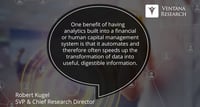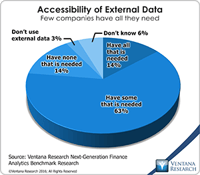Blockchains are attractive because their built-in security and trust factors make them useful for almost all business interactions involving organizations and individuals. Blockchains have two basic functions. One is as a method for handling transactions involving property such as land deeds, trademarks or other assets. The second involves exchanges of data such as identities of individuals or businesses, the location of an object at a point in time or weather conditions. All interactions...
Read More
Topics:
Big Data,
Data Science,
Mobile,
Marketing Performance Management,
Office of Finance,
Analytics,
Business Intelligence,
Cloud Computing,
Data Governance,
Data Integration,
Data Preparation,
Internet of Things,
Digital Technology,
Digital Marketing,
Digital Commerce,
Operations & Supply Chain
Workday recently presented a technology summit for industry analysts. The presentations focused on Workday’s ongoing product advancements as well as its approach to employing emerging technologies. These technologies include artificial intelligence (AI) and machine learning (ML), robotic process automation (RPA) and bots utilizing natural language processing. Ventana Research uses the term “robotic finance” to refer to these technologies when used in the office of finance. In our view, they...
Read More
Topics:
Big Data,
Data Science,
Mobile,
Machine Learning,
Office of Finance,
Continuous Planning,
Cloud Computing,
Collaboration,
Financial Performance Management,
ERP and Continuous Accounting
Oracle recently held its second ERP Cloud Summit with industry analysts. The all-day event wasn’t just about ERP. The company covered a range of its business applications, including financial performance management as well as its Adaptive Intelligent Applications. And it wasn’t just about the cloud. After more than a decade of steady developments, ERP systems have begun to change fundamentally, facilitated by the growing availability of new technologies including cloud computing, advanced...
Read More
Topics:
Big Data,
Data Science,
Mobile,
Customer Experience,
Human Capital Management,
Machine Learning,
Office of Finance,
Analytics,
Data Integration,
Internet of Things,
Cognitive Computing,
HRMS,
Financial Performance Management,
Mobile Marketing Digital Commerce,
Digital Marketing,
Digital Commerce,
Operations & Supply Chain,
Enterprise Resource Planning,
ERP and Continuous Accounting
Business process reengineering was a consulting fashion in the early 1990s that spurred many companies to purchase their first ERP systems. BPR proposes a fundamental redesign of core business processes to achieve substantial improvements in market and customer responsiveness, productivity, cycle times and quality. ERP systems support business process reengineering by guiding the step-by-step execution of the redesigned process to ensure that it is performed consistently. They also automate the...
Read More
Topics:
Big Data,
Data Science,
Mobile,
Customer Analytics,
Customer Experience,
Machine Learning,
Office of Finance,
Wearable Computing,
Continuous Planning,
business intelligence,
Analytics,
Cloud Computing,
Data Integration,
Internet of Things,
Financial Performance Management,
Digital Technology,
Digital Marketing,
Digital Commerce,
Operations & Supply Chain,
Enterprise Resource Planning,
Machine Learning and Cognitive Computing,
ERP and Continuous Accounting,
Sales Planning and Analytics
More businesses are using software to implement and support a strategic pricing strategy designed to optimize revenue and margins in business-to-business (B2B) transactions because it can help improve results at the bottom line. “Optimize” in this instance means managing the trade-off that usually exists between revenue and profitability objectives in order to support a company’s strategy and capabilities in a given market. Business-to-business pricing management is Ventana Research’s term for...
Read More
Topics:
Big Data,
Data Science,
Sales,
Office of Finance,
Analytics,
Cloud Computing,
Sales Performance Management,
Financial Performance Management,
Price and Revenue Management,
Pricing and Promotion Management,
Sales Enablement and Execution,
ERP and Continuous Accounting
Senior finance executives and finance organizations that want to improve their performance must recognize the value of technology as a key tool for doing high-quality work. Consider how poorly your organization would perform if it had to operate using 25-year-old software and hardware. Having the latest technology isn’t always necessary, but it’s important for executives to understand that technology shapes a finance organization’s ability to improve its overall effectiveness.
Read More
Topics:
Big Data,
Data Science,
Mobile,
Human Capital Management,
Mobile Technology,
Office of Finance,
Continuous Planning,
Analytics,
Business Intelligence,
Cloud Computing,
Collaboration,
Financial Performance Management,
Price and Revenue Management,
Inventory Optimization,
Operations & Supply Chain,
Enterprise Resource Planning,
Sales and Operations Planning,
Machine Learning and Cognitive Computing,
ERP and Continuous Accounting
Price and revenue optimization (PRO) is a business discipline used to produce demand-based pricing; it applies market segmentation techniques to achieve strategic objectives such as increased profitability or greater market share. In essence, PRO enables companies to surf the demand curve using dynamic rather than fixed pricing to achieve the most desirable trade-offs between revenue volume and profit margins. The trade-off is defined by strategic factors such as the company’s market position,...
Read More
Topics:
Big Data,
Data Science,
Sales,
Office of Finance,
Analytics,
Cloud Computing,
Sales Performance Management,
Financial Performance Management,
Price and Revenue Management,
Pricing and Promotion Management,
Sales Enablement and Execution,
ERP and Continuous Accounting
Using information technology to make data useful is as old as the Information Age. The difference today is that the volume and variety of available data has grown enormously. Big data gets almost all of the attention, but there’s also cryptic data. Both are difficult to harness using basic tools and require new technology to help organizations glean actionable information from the large and chaotic mass of data. “Big data” refers to extremely large data sets that may be analyzed computationally...
Read More
Topics:
Big Data,
Data Science,
Planning,
Predictive Analytics,
Social Media,
FP&A,
Office of Finance,
Operational Performance Management (OPM),
Budgeting,
Connotate,
cryptic,
equity research,
Finance Analytics,
Human Capital,
Kofax,
Statistics,
Analytics,
Business Analytics,
Business Intelligence,
Customer Performance Management (CPM),
Data,
Datawatch,
Financial Performance Management (FPM),
Kapow,
Sales Performance Management (SPM),
Supply Chain Performance Management (SCPM),
Strata+Hadoop

















